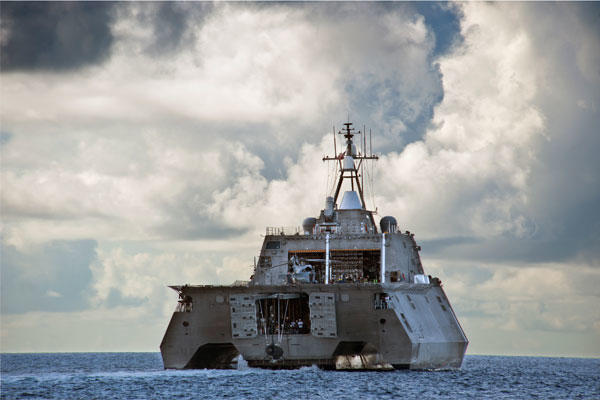The Director, Operational Test and Evaluation report released Wednesday specifies a host of concerns about the Navy's Littoral Combat Ship program, claiming problems with the platform's seaframes, mission packages, and weapons.
In particular, the report says that the LCS Freedom variant's 57mm and 30mm guns revealed performance, reliability and operator training deficiencies.
The $37 billion LCS program, in development since 2002, is a next-generation surface-ship aimed at delivering a fast, agile, littoral vessel equipped with technologically advanced mission packages.
The Jan. 27 report by the Pentagon's top testing agency also cited problems with the LCS' mine-countermeasures, anti-submarine warfare systems and surface warfare capabilities. The findings about the weapons were attributed to the Navy's own Quick Reaction Assessment report, which also examined the ship's Surface Warfare Package, or SUW.
Problems the LCS program, such as the ship's survivability in combat, have been highlighted multiple times in the past and Navy officials have said the LCS teams are working to correct them.
"The Navy appreciates the insights provided by DOT&E, which has consistently highlighted both effective warfare areas and programs, as well as recommendations for areas to re-visit. Most issues cited, in fact, have been ongoing areas of focus for the Navy, and many items were collectively identified within the test and evaluation community and have been addressed throughout the year long reporting period," said Lt. Robert Myers, a Navy spokesman.
The LCS class consists of two variants, the Freedom and Independence, designed and built by two industry teams, respectively led by Lockheed Martin and Austal USA. Contracts were awarded for the construction of up to 10 ships each.
The report says problems with the LCS 1's or USS Freedom's 57mm gun "prevented the ship from demonstrating that it can meet the Navy's SUW performance requirements."
However, the report did say that the SUW Increment II, as installed in the Freedom variant, "does enhance existing surface self-defense capability and provides additional capability to conduct maritime interdiction operations." The SUW Increment II mission package has not been tested on the Independence variant seaframe.
USS Freedom recently completed a 10-month long maiden deployment going to Singapore, South China Sea and the Philippines, among other places. The ship experienced technical issues on the journey such as problems with the diesel generators, air compressors and certain cables.
J. Michael Gilmore, head of DOT&E, cites these problems throughout the report released Wednesday. The Navy has already put a number of fixes in place to address these concerns and harvested lessons learned from the USS Freedom for the remainder of the LCS fleet, service officials have said.
In particular, the DOT&E report questioned the efficacy and readiness of the LCS Mine Countermeasures, or MCM, mission-package.
"LCS has yet to demonstrate whether the first increment of MCM capability will meet the Navy's reduced expectations for mine clearance. Even if this MCM package meets all of its final increment requirements, legacy systems will be needed to perform the full range of mine clearance operations," the report states.
The MCM mission package consists of a number of key elements such as the Remote Minehunting System's Remote Multi-Mission Vehicle or RMMV, an underwater mine-hunting technology. The report claims that additional testing will be necessary to more fully evaluate the system's reliability.
"Data from the recent developmental testing suggest that reliability may not have improved sufficiently to enable an LCS with two RMMVs onboard to complete the desired area search without having to return to port more often than currently planned and desired to obtain replacements," the report stated.
Chris Johnson, a Naval Sea Systems Command spokesman, responded to the critique saying the service instituted a reliability growth program for the Remote Minehunting System in 2011, and "the system is now meeting its performance objectives."
The Navy planned to build 52 Littoral Combat Ships, but OSD recently directed them to adjust the 2015 budget submission to fund only 32 of them. The ships are divided up among the two variants -- Freedom and Independence.
The report also questions the survivability of the LCS seaframes, calling them "lightly armed" for ships of their size.
"While both seaframes are fast and highly maneuverable, they are lightly armed for ships of this size and possess no significant capability without the planned SUW Increment IV mission package," the report cites.
The Independence variant's seaframe is largely untested when it comes to core combat capability, the report finds.
Navy officials have long said that the speed and maneuverability of the LCS, being able to reach 40-knots, is itself a survivability-enhancing feature. Secondly, Navy officials maintain that many of the concerns, questions and issues cited in the report are things the service is, or has been, already working on.
"Information in the report is gathered over the course of the year and a lot of it involves things we have already been working on," Myers said.
























